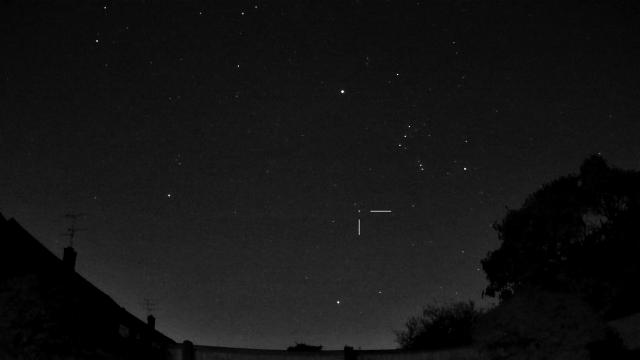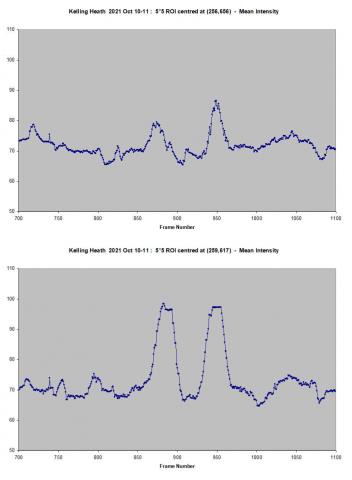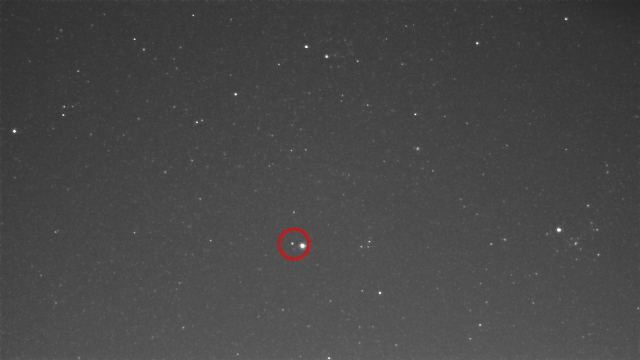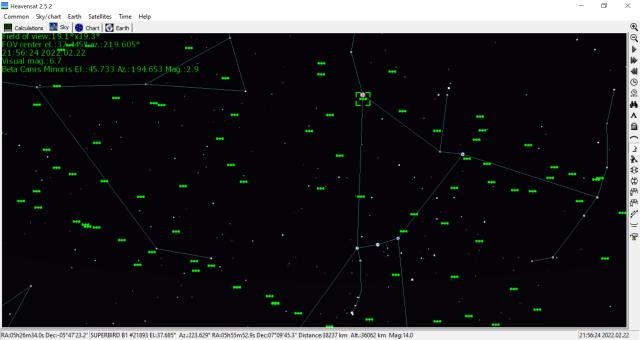› Forums › General Discussion › Flaring of synchronous satellites from Kelling Heath
- This topic has 16 replies, 7 voices, and was last updated 2 years, 1 month ago by
 Martin Lewis.
Martin Lewis.
-
AuthorPosts
-
25 October 2021 at 1:48 pm #575082
 Martin LewisParticipant
Martin LewisParticipantAt the recent Kelling Heath star party I ran my AllSkyCamera for the Friday, Saturday and Sunday nights. The results can be seen here:
https://vimeo.com/manage/videos/633708572 Friday 8th Oct
https://vimeo.com/manage/videos/633708719 Sat 9th Oct
https://vimeo.com/manage/videos/633709881 Sun 10th Oct
One of our group, Tevor Law, spotted some odd transient activity by eye in Cetus on the Sunday night and when reviewing the videos they show lots of these local brightenings in the Cetus area on the Sunday night, and in fact throughout the night on all three videos. These stellar brightenings stay fixed as the sky rotates and some must reach mag 2. The region where the activity takes place stays in Cetus though.
To see a prominent example look at the Sunday night video 20 seconds in (22.35UT on timestamp upper LH corner) and at just above the 9 o’clock position about 1/4 way to the zenith.
Rather than paraphrase what Trevor has said I will reproduce his comments and analysis below. When talking about timings he is talking about the Sunday night video:
However, it shed a lot of light (so to speak) on those transient events in Cetus I was getting excited about. It clearly showed they were drifting against the stars and fixed relative to the landscape and their apparent declination was 7 °S which means they were almost certainly Geostationary satellites. 7°S is about where you’d expect to see them from our latitude.I was surprised at how bright they could become considering the distance, almost mag +2. The ISS reaches mag -3 or so but these things are around 100 times further away. Inverse square law would imply 10,000 fold diminution of brightness, or 10 magnitudes. Sun-glint? I was further surprised at just how many there were and how long it all went on for. The first one was at 0m 24s (22:53) and the last at 01m 06s (02:34) and that was only ended by the low cloud. There were quite a number between 0m 40s (00:14) and 00:49 (01:00)
This also raises further questions. Why did it stick so assiduously to Cetus? For clarification, they usually appeared above the quadrilateral consisting of ζ, θ, η and τ Ceti, the one that sort-of resembles the bowl of the Plough as seen from northern Australia. Early images could be to the right of there and later ones to the left but always in Cetus. The apparent RA of the phenomena was between ~1h and ~2h. The RA of the Sun then was 13h 06m, so it was at the anti-solar RA
This was only 3 weeks or so after the Equinox, so why weren’t they in the Earth’s shadow? I can’t properly answer this one. On the Sunday night, the Sun’s declination was (by coincidence) 7.0°S. At the geocentric distance of the Geostationary orbit, 26,200 miles (to 3 sig fig), according to my calculations that would put the axis of the Earth’s shadow some 3220 miles above the orbit. However, again according to my calculations, the radius of the Earth’s Umbral shadow at that distance (ignoring refraction due to the atmosphere, which would reduce it but by how much?) would be 3830 miles, some 600-odd miles bigger, implying the Geostationary satellites would dip into the Earth’s shadow…
Was it unique to the Sunday night? No. I checked the other two nights and the phenomenon appeared on both nights. Not till 1m 31s (01:52) on the Sat, due to the earlier fog/low cloud but Fri was similar to Sun, albeit somewhat fewer.
Has anyone else noticed similar in the past? It is quite a striking phenomenon so am surprised I’ve not heard of synchronous satellite flares before.
Martin
25 October 2021 at 10:41 pm #584845 Grant PrivettParticipant
Grant PrivettParticipantFlares happen petty much every night (if the satellite isn’t eclipsed by the Earth). I have certainly recorded some as mag 5.
Worth noting that, depending on their stance, they may not flare when they are nearest the antisolar point, but up to 45 minutes earlier or later. I recorded one flare 3 hours later than antisolar – but that satellite was thrusting at the time.
25 October 2021 at 11:47 pm #584846 Martin LewisParticipant
Martin LewisParticipantThanks Grant,
These are much brighter than 5th magnitude though. Some were definitely 2nd magnitude.I guess they would be in the Earth’s shadow at the anti-solar point that’s maybe why they are brighter 45 mins before or after.
Martin
26 October 2021 at 12:10 am #584847 Grant PrivettParticipant
Grant PrivettParticipantI think its more to do with the angle the solar panels are being maintained at.
I was impressed enough with them making naked-eye visibility. 🙂
26 October 2021 at 7:44 am #584849 Nick JamesParticipant
Nick JamesParticipantIf you do the calculations it is not that surprising if it is a specular reflection from the solar panels. Around opposition these are pointing straight back at us and they are quite large. A quick order of magnitude calculation follows. Please check!
The sun has an apparent area of around 1E-4 rad^2. A 1m^2 mirror at 40,000 km is around 1E-15 rad^2. Assuming the mirror is a perfect reflector it will have the same surface brightness as the sun so will be 2.5 log10(1E-11) fainter so around 28 mags. The sun is mag -27 so the 1m^2 mirror in GEO could be around mag 1. GEO satellites have solar arrays of 50m^2 or more so a bright NE glint is certainly possible.
30 October 2021 at 11:37 am #584873 Martin LewisParticipant
Martin LewisParticipantTo make this clearer I have cropped and rotated the video from the Sunday night (10th Oct) and boosted the brightness. Multiple flares occur across the mid line of the video as the anti-solar point moves across the southern sky from L to R. This runs from 22.18UT to 1-13UT. You can see the video here: https://vimeo.com/640645977
Martin
30 October 2021 at 11:22 pm #584874 Nick JamesParticipant
Nick JamesParticipantThat is a very interesting video. I’ve estimated the time of the brightest one as 2021-10-11 00:26 and its position as azimuth 177, alt 29. If you search within 2 deg of that for Kelling you get this list of satellites (This is a bit of a mess but I can’t attach a text file since it is not one of the permitted file types:
UTC ID Az Alt Ofs Rg (km) RR (km/s)
===========================================================================================================
2021-10-11 00:26:00.000000 UTC TOPO 24748 175.99 28.87 1.16 39039.51 -0.070 DIRECTV 6 (TEMPO 2)
2021-10-11 00:26:00.000000 UTC TOPO 32299 175.37 29.43 1.91 38664.80 -0.000 ASTRA 4A (SIRIUS 4)
2021-10-11 00:26:00.000000 UTC TOPO 33414 175.84 28.30 1.50 39268.93 0.004 VENESAT-1
2021-10-11 00:26:00.000000 UTC TOPO 36831 177.75 29.53 1.01 38670.19 0.000 RASCOM QAF 1R
2021-10-11 00:26:00.000000 UTC TOPO 39773 177.53 29.57 0.84 38665.08 -0.001 EUTE 3BMy guess is that the bright one is Eutelsat 3B. It has large solar panels (around 70 m^2) and could certainly flare to negative magnitudes if the geometry was right.
31 October 2021 at 9:52 am #584876 Martin LewisParticipant
Martin LewisParticipantInteresting analysis Nick. What website is that data from?
Thanks
Martin31 October 2021 at 5:36 pm #584877 Nick JamesParticipant
Nick JamesParticipantI don’t know whether there is a website which allows you to search for satellites which are in a particular direction at a given time but I computed these directly using TLEs downloaded from here.
1 November 2021 at 7:57 am #584879 Dr Paul LeylandParticipant
Dr Paul LeylandParticipantThere are (at least) two ways round the text file attachment issue. The obvious is to put your text into a doc/docx/pptx file. The recipient can then convert it back to text with a simple cut and paste.
The other is to rename the file because the uploader works on the extension not the contents. See here for an example.
3 November 2021 at 7:55 pm #584883 Nick JamesParticipant
Nick JamesParticipantHere is what one of those GEO flares looks like in real time. The attached is a still from a meteor camera video which you can see here. The video starts at 2021-11-03 01:09:45 UTC and the flare reaches around 2nd mag at 01:09:56 and lasts for around 15s. The potential candidates within 0.1 deg of the estimated position are:
2021-11-03 01:09:56.000000 UTC TOPO 28238 143.17 24.40 0.07 39494.87 -0.009 DIRECTV 7S
2021-11-03 01:09:56.000000 UTC TOPO 38741 143.07 24.34 0.07 39129.06 -0.000 HYLAS 2
2021-11-03 01:09:56.000000 UTC TOPO 47306 143.17 24.36 0.08 39122.74 0.000 TURKSAT 5AThe solar phase angle at the time of this flare was 125 deg so nowhere near opposition.
 4 November 2021 at 6:30 pm #584887
4 November 2021 at 6:30 pm #584887 Nick JamesParticipant
Nick JamesParticipantI suspect that this particular flare was caused by DirecTV 7S. It was boosted to the graveyard orbit at the start of 2021 (see here) which is why it is around 370km higher than the other two. It would have been passivated and would not be under control which would explain the odd geometry for this glint.
7 November 2021 at 11:17 am #584895Mr Wiliam Graeme Waddington
ParticipantNice videos!
I decided to look at the Sunday video in a little detail and so extracted 743 frames from it, starting at 378 (zero-offset),
i.e. 2021-10-10 22:25:10.656, covering the mainly clear period.
Using ImageJ to MAX-add the frame stack showed 14 GEOS away from the star trails. Further examination revealed a total of 26 flares in the 3h 10min covered.
Of particular interest is that three pixels of the video flare on two separate occasions.Counting from the top-left corner these are (247,485) at 22:32 and 23:20, (255,656) at 00:32 and
00:51, and (259,617) at 00:35 and 00:51.
The first of these appears to be flares from unconnected satellites: the 22:32 flare is from Es’Hail 1 the second from
either Intelsat Hotbird 13E or Intelsat Hotbird 13B.
The second double-flare consists of 5th and 4th magnitude flares from Eutelsat 5 West A by my reckoning.
The third pair are both mag 3 and could originate from either Intelsat 1002 or MEV 2 or, indeed, one from each.In the case of Eutelsat 5 West A, which seems to be responsible for both of the flares at (255,656), it is possible that the first
(mv = 5) brightening results from the general diffuse reflection of sunlight from the solar panels whereas the second, brighter, one is the actual specular glint from the panels. GEO phase functions having a peak either side of zero phase are not uncommon.The following shows the traces of the second and third flare-pairs
.
7 November 2021 at 11:22 am #584896Mr Wiliam Graeme Waddington
ParticipantThe JPEG of the z-stack traces seems to have disappeared into the ether. Here it is
 26 February 2022 at 2:54 am #585272
26 February 2022 at 2:54 am #585272Trevor Law
ParticipantAs discussed in the first post of this thread, this phenomenon of flaring up to mag 2, ascribed to specular reflection from geostationary satellites, almost certainly from their solar panels, was shown on Martin Lewis’ all-sky videos, recorded at Kelling Heath on 08-09, 09-10 and 10-11 October 2021, most spectacularly in the latter. Subsequent to this, he suggested I look through his previous all-sky videos to see if anything could be spotted. I drew a blank, even from ones whose dates were less than a fortnight away from those above.
The conjecture has to be that this phenomenon can only normally be seen, at least for the latitudes of Southern England, when δ☉ = -7º ± 1º. The Sun reaches -8º on March 1st and -6º during March 5th. It might therefore be interesting to keep an eye out for this in the next week or so. As it seems to centre roughly around the anti-solar R.A., though at a Dec of about -7º, that would put against the rather dim area near the borders of Leo, Hya and Sex, so, if it happens, it should be easy enough to spot. Perhaps an easier way of visualising it is at around the same altitude as Alphard but under Leo.
My guess is that, with the apparent declination of the geostationary orbit being slightly further South as seen from e.g. Scotland, it’s possible the phenomenon may already have started from those latitudes.
26 February 2022 at 5:01 pm #585274 Peter MeadowsParticipant
Peter MeadowsParticipantOn the night of 22/23 Feb a bright geostationary satellite was seen for 6 hours from 18:50 to 00:49 UT using a RMS meteor camera pointing SW from Chelmsford, Essex. A single 10s frame is shown below – the red circle includes Betelgeuse (closest at 21:58 UT). The satellite is at about mag 2 being a bit fainter than gamma Orionis (Bellatrix) at mag 1.6. Also shown below is a composite for every 5th frame (minus a few due to cloud) showing the change in altitude/azimuth during the 6 hours, within red ellipse, due to parallax I assume. The satellite appears to loop around the track of Betelgeuse. It appeared in every other frame giving a time interval between flashes of ~20s.


Further investigation indicate that this is Superbird B1 Communications satellite NORAD ID 21893, COSPAR ID 1992-010A in a 36,063 x 36,198 km, 13.8° orbit as determined by Heavensat in the screenshot below when near to Betelgeuse. This software can also show when geostationary satellites are in the Earth’s shadow.
 20 November 2023 at 12:00 am #620216
20 November 2023 at 12:00 am #620216 Martin LewisParticipant
Martin LewisParticipantRan my AllSky Camera again from Kelling Heath at the Equinox Sky Camp and on Friday 13th Oct. 2023 and got an even better time-lapse video showing large numbers of geostationary satellites above naked eye visibility.
Have done a crop of the Southern sky which includes the UT clock at the left hand edge: Video can be found at: https://www.youtube.com/watch?v=zOrSYaT4rgQ
For those interested, the geostationary satellites are in a band half way up the screen in the time lapse video. They are at the anti-solar point which starts at the left hand side and moves to the right as the night progresses. At 00.27UT, 45 secs in, about 9 satellites are seen in a swarm with some flaring to mag ~2.
Cheers
Martin -
AuthorPosts
- You must be logged in to reply to this topic.
